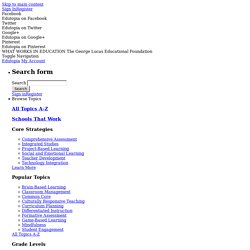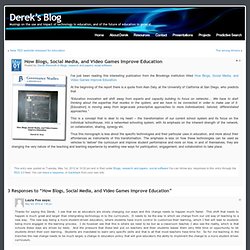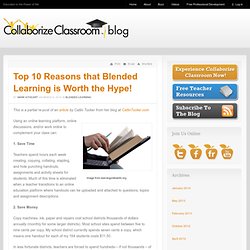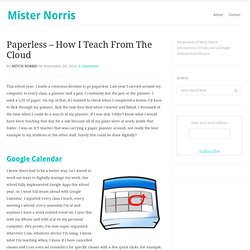

The rise of K12 blended learning. Www.passged.com/media/pdf/blended-learning/teachers-guide.pdf. Beyond blended learning: Reaching every student. At the 2010 NCTIES conference in Raleigh, LEARN NC’s Bobby Hobgood delivered a presentation about blended learning. The archived session is available at the following link: Access to the archived session requires Microsoft Silverlight software. If you don’t already have Silverlight installed, clicking on the link will prompt your browser to ask you if you’d like to download the software. About this presentation Presentation title. Sharing time in a blended learning space. Joseph is a typical student who is reading a novel about the internment of Japanese-American citizens during the aftermath of World War II. Like many high English language arts sessions, this one includes plenty of in-class guided discussions that are led by the teacher.
But Joseph’s learning and inquiry extends beyond the classroom walls and beyond the school day. Blended Learning.
Blended Learning. The Difference Between K-5 and 6-12 Blended Learning. I’ve been doing a lot of thinking about blended learning in a k-5 setting lately. To be honest, I see it working beautifully in a 6-12 environment. As a teacher at an international school in China, I can assume that the students come to class with a set of online social networking skills. It’s “simply” a matter of giving the student the opportunity to transfer those skills to a formal blended learning environment.
Afterall, it’s not a giant leap to go from Facebook to a Discussion Form in Moodle. The kids get quickly get past the technology and concentrate on honing their skills around reflection, analysis and online collaboration. But what about students in the k-5 environment? Planning – Create a higher level of scripted content, providing more guidance and structure for the young learner.Resources – Use items like Google’s Custom Search to narrow the sites that students see when they conduct research.
Blended Learning. What is Blended Learning? — Web Learning @ Penn State. Blended Learning Resources. 7 Reasons Why Blended Learning Makes Sense. SMARTER SCHOOLS | by Michael Spencer Education no longer comes in rows and textbooks, but from a combination of sources.

Let’s start with a definition. What exactly is blended learning? Here’s a great, generally useful definition found on the City Prep Academies website that clarifies the term: “[Blended learning] integrates face-to-face classroom time with online learning (facilitated at all times by a classroom teacher), combining the effectiveness and socialization of the classroom with technology-enhanced online materials.” What makes blended learning especially appealing is that it provides students with courses that wouldn’t otherwise be available; teachers get near-instant student assessments and the opportunity to provide their students with individualized instruction. 1. 2. 3. 4. 5. 6. 7.
If we’re excited and responsible in how we use technology for learning—then, like never before—the future of education is ours to create. Blended Learning at GrayHarriman.com. Blended Learning: A Disruptive Innovation [INFOGRAPHIC] #edtech #edutech. Classifying k-12 blended learning. Redirecting. PBL on The Block. The rise of K-12 blended learning. Blended Learning: Combining Face-to-Face and Online Education. There's this myth in the brick and mortar schools that somehow the onset of online K-12 learning will be the death of face-to-face (F2F) interaction.

However this isn't so -- or at least in the interest of the future of rigor in education, it shouldn't be. How Blogs, Social Media, and Video Games Improve Education. I've just been reading this interesting publication from the Brookings institution titled How Blogs, Social Media, and Video Games Improve Education.

At the beginning of the report there is a quote from Alan Daly, at the University of California at San Diego, who predicts that "Education innovation will shift away from experts and capacity building to focus on networks… We have to start thinking about the expertise that resides in the system, and we have to be connected in order to make use of it. [Education] is moving away from large-scale prescriptive approaches to more individualized, tailored, differentiated approaches.” This is a concept that is dear to my heart – the transformation of our current school system and its focus on the individual 'schoolhouse, into a networked schooling system, with its emphasis on the inherent strength of the network, on collaboration, sharing, synergy etc.
Galleries on Education. Top 10 Reasons that Blended Learning is Worth the Hype! This is a partial re-post of an article by Catlin Tucker from her blog at CatlinTucker.com Image from learningonlineinfo.org Using an online learning platform, online discussions, and/or work online to complement your class can: 1.

Save Time Teachers spend hours each week creating, copying, collating, stapling, and hole punching handouts, assignments and activity sheets for students. 2. Copy machines, ink, paper and repairs cost school districts thousands of dollars annually (monthly for some larger districts). In less fortunate districts, teachers are forced to spend hundreds— if not thousands – of dollars of their own money to supplement classroom resources. Teachers can save money and paper by posting assignments, directions, notes, reading materials online. 3. Online discussions and collaborative group work free teachers from their role as the only source of information and feedback. 4. 5. 6. Training Teachers to Integrate Technology. Stacey Davis, Ron Beazer and Mike Smith used to do a lot of "drive-by training.

" They, along with their colleagues in Baltimore City Public Schools' Teacher Student Support (TSS) group, would conduct two-hour workshops and get teachers excited about using technology in their classrooms. But within a day or two, as workloads mounted, the teachers would resume their old habits and those training sessions would fade from memory. Some of the district's 204 campuses and programs have made major investments in technology, making the wheel-spinning all the more troubling. "Our concern," explains Davis, a functional analyst for TSS, "is if you're spending all this money on technology, do you have a good plan for it?
If not, let us come in and help you. " It's a common concern among instructional technologists: Bringing technology tools into the classroom doesn't necessarily mean that teachers are leveraging them to develop students' 21st century skills. Follow the Leader Dream Team. Bobby Hobgood's Wiki. The rise of K-12 blended learning: Profiles of emerging models. Paperless – How I Teach From The Cloud « Mister Norris. This school year, I made a conscious decision to go paperless.

Last year I carried around my computer to every class, a planner and a pen. I constantly lost the pen or the planner. I used a LOT of paper. On top of that, if I wanted to check when I completed a lesson, I’d have to flick through my planner, find the task then find when I started and fished. Blended learning.